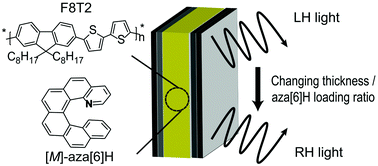Engineering the sign of circularly polarized emission in achiral polymer – chiral small molecule blends as a function of blend ratio†‡
Abstract
Circularly polarized organic light-emitting diodes (CP-OLEDs) that demonstrate both state-of-the-art efficiency and strongly circularly polarized (CP) electroluminescence have proved a considerable technical challenge. Furthermore, multiple factors – from film thickness to device structure – have been shown to influence the sign of the emitted CP light, independent of the handedness (absolute stereochemistry) of the chiral emitter. Here we report CP-OLEDs using a blend of poly(9,9-dioctylfluorene-alt-bithiophene) (F8T2) and a chiral small molecule additive (1-aza[6]helicene, aza[6]H). We demonstrate CP-OLEDs with an impressive electroluminescence dissymmetry (gEL) > 0.3 and a current efficiency of 0.53 cd A−1 and brightness of 3023 cd m−2. While at low aza[6]H loadings, F8T2 blends are consistent with previous observations of CP dissymetric inversion as a function of film thickness/excitation mode, a higher loading of aza[6]H (∼40 wt%) removes such dependencies while retaining excellent g-factors. The materials disclosed will allow for further mechanistic studies of chiral polymeric materials and provide new opportunities for chiroptical optimisation in films and devices.

- This article is part of the themed collections: 2022 Journal of Materials Chemistry Lectureship runners-up: Jessica Wade and Luisa Whittaker-Brooks and Special issue in memoriam of Alasdair James Campbell


 Please wait while we load your content...
Please wait while we load your content...